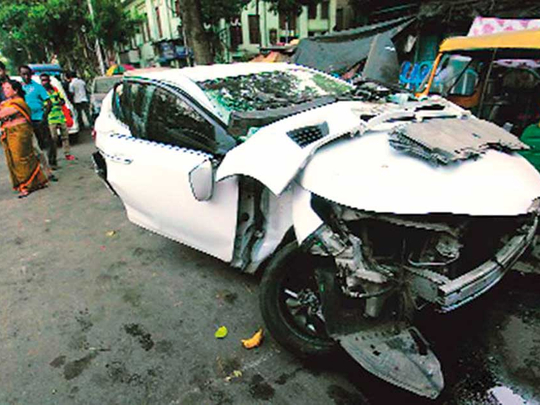
Dubai: Pub-hopping until the wee hours of the morning, followed by a high-speed road crash, and the death of a celebrity.
Could be part of the script for a racy flick or paperback or the latest soap opera to hit the idiot box … Right?
But it could also be so very real, so very ‘here’ and ‘now’, as Kolkata found out to its utter shock and horror last April 29. Promising model and television anchor Sonika Singh Chauhan, all of 27, was seated in the front seat of the Toyota Corolla Altis driven by her rumoured boyfriend and actor Bikram Chatterjee, when the sedan crashed against the side railings and turned turtle on the pavement on Rashbehari Avenue. There is evidence to suggest that Bikram was driving under the influence and the car’s event data recorder has revealed the vehicle had exceeded the speed limit by about 65km/h, barely six seconds before the crash. The horrific accident punctuated, rather brutally, a life rich in vivaciousness. Sonika and Bikram were partying with friends at multiple venues in the city barely a few hours before the crash. While Bikram escaped with minor injuries, presumably because he had strapped the seatbelt on, Sonika died about an hour after being admitted to hospital.
Now, just replace the protagonists and the make of the vehicle with a set of names that randomly come to your mind and think of any other city or large township in contemporary India: You are bound to be confronted with an echo of rather eerie familiarity. In a 1.32 billion-strong nation, road rage and accidents have become so frighteningly commonplace that they do not even figure as automatic Page One-choices, unless of course there’s a celebrity name involved, as in the case of Bikram-Sonika or for that matter the infamous hit-and-run incident allegedly involving Bollywood bigwig Salman Khan in Mumbai some years back.
But apart from the obvious medico-legal angles that a case such as Sonika’s death or the Salman incident would entail, is there a deep-rooted social malaise as well that time and again manifests itself in life lived not just on the fast lane, literally, but also on the wrong lane, so to speak? We keep talking about a young, bright India earning rave reviews, hitting the headlines for all the right reasons — from sports to IT to entertainment to politics ... But is a certain brashness and impatience collateral damage for the fast-changing socioeconomic demographics in the world’s second-most populous nation and Asia’s third largest economy? Do the Bikrams and Salmans constitute only a microcosm of a larger hubris that is threatening to leave its imprint pan-India?
For Ashis Nandy, senior honorary fellow at the New Delhi-based Centre for the Study of Developing Societies, Sonika’s death or for that matter the pavement-dweller’s death in the Salman incident, are mere symptoms of a bigger danger that has been brewing amid all the glossing over. “There is a certain ‘anxiety of anonymity’ that seems to be engulfing dwellers in large cities in India. This ‘anxiety of anonymity’ can affect a celebrity as well, no matter how famous he or she may be. This urge to prove ‘who I am’ ...
“For a traditionally agrarian economy like India, 60 per cent of which even today dwells in its villages, the march from agrarian to an industrial economy, nonetheless, has been quite considerable over the last few decades. And the danger primarily lies in these sprawling cities and urban centres that have come up and continue to grow. For a very large number of city-dwellers, particularly the youth, there is an urgency to show off one’s masculinity by indulging in rash driving and over-speeding,” Nandy said. “Added to this masculinity is a sense of impunity — that one is above the law owing to one’s social status or political influence. It is a combination of such factors that often lead us to a Sonika-like tragic end,” Nandy told Gulf News.
Sense of responsibility
Nandy’s words found a resonance in what actress Sreelekha Mitra had to share. “We live in a time when there are far too many enticements for one to lose one’s bearings. Just see the kind of advertisements we are daily bombarded with. Talking of aspirational levels, such flawed, exaggerated depictions are bound to take a toll on rational thinking for some people. This is where our sense of responsibility should come into play. If Bikram was indeed under the influence, he had no business getting behind the wheel that night,” Sreelekha told Gulf News.
For social activist and academic Miratun Nahar, much of the ‘anxiety’ and ‘restlessness’ that we see today in contemporary Indian society are in a way inevitable and we have to learn to live with them the best way we can, until we come to the bend, when the clock gets reset on its own. Speaking to Gulf News from Kolkata, Nahar said: “In India, society is known to have owned up its guardianship and directed the youth in a way it has thought fit. This trend has continued for too long. What we are seeing now is a backlash to that guardianship. While the youth in the past had accepted that guardianship and happily followed the course that society had charted out for them, the present generation is showing a very definitive mindset to overrule that authority. This is an antithesis to the earlier order and this will continue until there is a further backlash to return us to our earlier social moorings.”
While Sreelekha mentioned the negative role that advertisements sometimes play in skewing people’s aspiration levels, filmmaker and theatre personality Ashok Viswanathan cautioned against the culture of “Page 3 journalism” that can lead to megalomania. “In this age of Page 3 journalism, media also has a very crucial role to play. The hype generated over someone can even lead to megalomania. It can make a person with very mediocre credentials feel like a superhero, leading him to believe he is a James Bond of sorts. But unfortunately, when it comes to the crunch, Bond’s car can take flight and avert an impending disaster, whereas the vehicle that Bikram Chatterjee was driving wasn’t built to fly!” Wealth and personal possessions definitely have a role to play in this milieu. While if-you-have-it-you-flaunt-it seems to be the flavour of the day, perhaps in keeping with the instant charm of a 20-20 cricket match, wherein a result is possible in a few hours and not days, unlike a Test match, the ‘here’ and ‘now’ seem to really matter a lot for the current generation of Indians.
Perception of well-being
“It can be your new sportscar or your girlfriend. Showing off matters,” Nandy says. “There has been a very big change in the way people perceive their personal well-being in India today. Earlier, maintaining a certain air of humility about one’s material possessions was considered to be part of one’s status symbol. Now, it counts to be flashy.”
Sreelekha is quite right, perhaps, when she says that it will be wrong to look for a villain in the Sonika incident because, all said and done, it was indeed an accident that could have killed Bikram as well. “The problem is that things sometimes get blown out of proportion due to the involvement of celebrities,” she reasoned.
While it is indeed pointless to indulge in a witch-hunt, Viswanathan had this poignant observation that perhaps puts things in perspective: “In this story, there are no heroes, no villains and no one is a winner in the end. But perhaps in this time of ‘Half Girlfriends’, we have ended up with ‘half villains’.”













